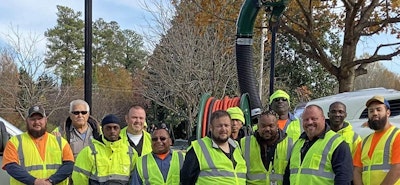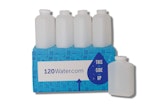Interested in Infrastructure?
Get Infrastructure articles, news and videos right in your inbox! Sign up now.
Infrastructure + Get AlertsWhen the U.S. Environmental Protection Agency announced the first stages of requirements for the Lead and Copper Rule Revisions in December 2021, the city of Smyrna, Georgia, decided to get a jump on mapping out its service line inventory. In early 2021, the city began organizing its approach, starting by contracting with a private company, 120Water, for a turnkey solution for lead program management.
The update to the Lead and Copper Rule, first published in 1991, is extensive. By Oct. 16, 2024, all public water systems must complete a lead service line inventory that accounts for every service line in their systems — and a plan to update that inventory going forward. A three-year compliance window is, for many public water systems, challenging at best due to small staff and small budgets.
For more than a year, 120Water helped Smyrna collaborate with other local government departments and utility offices to launch their preliminary inventory, which has put them in a prime position to be compliant by October 2024. Their success is charting the map for how to effectively mobilize a utility to comply with the new regulations and deliver safe drinking water.
High consumer expectations
Smyrna is a suburb located northwest of Atlanta in Cobb County. Its citizens are highly informed and engaged, so the Public Works Department knew it needed to get started immediately on a solid LCRR compliance plan. With a population of 55,000 and 16,000 service connections, Bo Jones, the city’s assistant director of public works, did not want to wait for additional state guidance to get started and risk missing the federal deadline.
A main component of the October 2024 deadline is a service line inventory, which is a map of all lines in a water system and what they are made of. Over the life of a water system, service lines can be added or removed, often without documentation, and records become lost. Furthermore, a very small number of U.S. water system service line maps have been digitized.
While Smyrna was ahead of the game regarding certain elements, Jones was well-versed in the length of time most compliance programs take from start to finish, so his first step was to engage the services of 120Water.
Working with specialists
One way for utilities with a small staff to quickly ramp up their compliance response is to invest in a solution that can help them meet their inventory and program execution needs efficiently and effectively. To that end, the city of Smyrna asked for help from 120Water, a digital water company with software, kits and services that supports government agencies and public water systems in managing their drinking water compliance programs. With a focus on LCRR compliance management and service line inventories, 120Water was able to accelerate the city of Smyrna’s compliance response.
Developing Smyrna’s lead service line inventory began with data collection from a variety of sources including GIS and billing data and historical tap cards. As part of their contract, program managers from 120Water ran down every avenue to better understand the status of all 16,000 connections in the system, which culminated with the preliminary inventory. In Smyrna’s case, the preliminary inventory revealed approximately 5,000 “unknowns” — about one-third of the entire system and a wildly larger number than expected. Smyrna plans to eliminate as many of those unknowns before the compliance deadline, while also immediately replacing every city-side lead pipe and connection when they find it.
While the inventory work was being managed by 120Water, the Smyrna Public Works Department also collaborated with other departments to advance their efforts. For example, in the midst of a construction boom, they collaborated with their building codes department to require renovations of greater than 50% of a building, including teardowns/rebuilds, to replace their service line, a practice that was not codified previously. This already has resulted in more than 100 service lines being updated to current standards, having a reductive impact on inventory “unknowns.”
The EPA has prioritized schools and daycare centers in the LCRR, so the city of Smyrna sent its first batch of test kits to all such buildings in the system to test their service lines. To date, 80% of these facilities have participated in the testing program.
Under LCRR, unknown service lines must be classified as lead until the material of the line can be validated using an accepted method. So, to tackle the long list of customers with an unknown lead service line status, 120Water deployed a residential testing campaign using a multi-liter method. Sequential sampling allows Smyrna to detect if there is a lead line present on the public or private-owned portions of the line, or both, and is a significantly less invasive method compared to potholing or excavation. Jones knew his community would not be agreeable to their lawns being torn up and wanted to ensure he had the community on his side throughout his inventory efforts.
The testing program, which is now underway, includes an educational postcard informing customers of the need to test for lead pipes, followed two weeks later with a free testing kit delivered to their doors. Customers are encouraged to take water samples and send them back to the utility — at no charge. A $25 billing credit is offered to encourage customers to complete the test.
To differentiate between lead coming from customer supply lines vs. city pipes, the testing kits instructed customers to fill five 1-liter bottles after waiting at least four hours without using water. The bottles are then returned postage-paid to an EPA-approved testing site and results are sent from the lab directly to 120Water’s digital platform, where Smyrna officials can login to view the results. With this method, the utility ensured that water from both the home’s piping (first liter) and the city’s piping (fifth liter) would be tested, helping to narrow down the source of any lead detected.
Funding challenges
The potential costs for the inventory and line replacement can be daunting, especially for small water systems. The Association of State Drinking Water Administrators estimates that the revisions could add five million hours of workload for systems over the next five years and cost more than $47 billion to enact.
For Smryna, the worst-case scenario — replacing all city-side supply lines — would be an approximately $12 million price tag. This incentivized the utility and the city of Smyrna to invest in getting help with the LSL inventory, which would identify a significant portion of lines that would not need replacing. Using 120Water would cost the city of Smyrna a tiny fraction of their worst-case scenario. In fact, verifying service line materials rather than assuming replacement for 5,000 lines has resulted in a 1,200% savings to date.
To pay for inventory support from 120Water and subsequent lead service line replacement, Public Works allocated a portion of its own operating budget and successfully requested a capital improvement line from the city of Smyrna. The department also applied for and received a $4 million federal American Rescue Plan Act grant due to eligibility as an infrastructure improvement project. Going forward, the city of Smyrna plans to apply for funds from the recently enacted Infrastructure Investment and Jobs Act (also known as the Bipartisan Infrastructure Law), which includes $15 billion for lead remediation.
Lessons learned
For most water utilities, mapping their service lines and identifying all lead service lines will be an enormous project, made even more challenging by the requirement for it all to be publicly available. Getting expert help is paramount to both the quality of work and meeting the compliance deadline.
The work is arduous, and utilities shouldn’t delay in getting started. For most public works departments and water utilities, the LCRR is not the only priority staring them in the face, and yet missed compliance deadlines mean fines. Departments and utilities need to act together and act now to jump-start their LCRR compliance effort. Don’t wait on final state guidance, Jones advises, because doing so will likely not give your utility enough time to complete its LSL inventory.
“Get started immediately,” Jones says. “The process will take much longer than you think, so starting early and getting professional help is critical.”
While doing the inventory, take advantage of the opportunity to get as granular as possible, documenting every detail available to you, such as precise physical addresses, line replacement and/or repair dates and detailed pipe material notes. The more documentation you do now, the better off you’ll be down the road.
Significant federal funds are available from both ARPA funds (which must be obligated by December 31, 2024) and the Infrastructure Investment and Jobs Act/Bipartisan Infrastructure Law. Portions of these federal funds are designed expressly to help utilities improve their systems and comply with regulations, so utilities should take full advantage of the opportunity to get grant assistance. Each state also has unique funding opportunities for water systems, so be sure to check with regulators on state and local funding avenues.
Eligibility for accessing these funds, however, depends on certain digitalization requirements and in some cases, a fundamental understanding of existing lead service lines. States are starting to announce assistance programs to help water utilities make the necessary investments to be eligible for federal funds. And even if your state isn’t yet offering assistance, apply for federal aid anyway.
“When you apply for federal funds, be human,” Jones says. “Help them get to know your community as people, sharing details of the challenges your neighborhoods face and how the ARPA or BIL funds would make a positive impact on human lives.”









